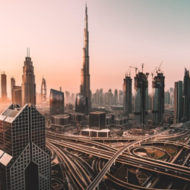Qatar adopts a long-awaited PPP law: will it really be a revolution?
2 July 2020
Qatar adopts a long-awaited PPP law: will it really be a revolution?
On 31 May 2020, the Emir of Qatar issued Law n°12 of 2020 “on regulating the partnership between public and private sectors” (the “PPP Law”)[1].
This is the epilogue of a long-running story which started around 2007. The government engaged several international law firms to provide advice in respect of the drafting of a law according to international standards. The PPP Law was announced several times in the past as a piece of legislation to be imminently issued but its enactment had been postponed every time.
As we will discuss below, the PPP Law is a welcome development but probably not a revolutionary one. As a matter of fact, PPP-type transactions have been implemented in Qatar for some years already, mainly by the Qatar Electricity and Water Authority (Kahramaa)[2] and by the Public Works Authority (Ashghal)[3] and sometimes by others[4].
This is because the legal framework in Qatar already provided a solid foundation for the development of projects under a PPP model (a “PPP Project” or a “Project”), including in respect of the possibility of establishing a special purpose vehicle between public and private stakeholders (the “Project Company”) or the ability of financiers to take some security interest over the Project Company[5].
Nonetheless, the PPP Law now provides a dedicated legislation aimed at encouraging the development of private sector participation in the construction and operation of public assets. It sends a positive signal to international sponsors and lenders.
However, it should be stressed that the PPP Law will not be practically implemented until the Minister has taken the necessary decisions to that effect[6].
This initiative by Qatar is not isolated within the Gulf region: whereas Kuwait developed a PPP legislation many years ago already[7], others have followed suit[8] so much so that all Gulf countries, with the exception of Bahrein, already have or should have a PPP legislation in place in the near future.
A new framework providing clarity and flexibility
The PPP Law covers a wide array of possible forms of PPPs including the BOT model, the BTO model, a BOOT model and O&M model but also “the allocation of lands through lease or usufruct licenses” and “any other model approved by the Council of Ministers” (art. 3).
In particular, it means that the ownership of the Project’s assets may be either vested with the State or with the Project Company (art. 17-2). Where applicable, the Project Company will be allowed to generate revenues through the collection of users’ fees or the financial returns from the Project (art. 21).
As per art. 17 of the PPP Law, there is a large degree of contractual freedom as to the definition of the rights and obligations in the contract to be entered between the public authority (called the “Contracting Authority”) and the Project Company (such contract being called the “Partnership Contract”).
Additionally, resorting to PPPs is open to a Contracting Authority which is defined as “any Government Agency (being a ministry, a public authority or a public institution) that concludes a Partnership Contract with the private sector”.
However, this freedom is relative and should be exercised within the framework prescribed by the PPP Law[9] and by the laws of Qatar in general, which are set to apply to the Partnership Contract (art. 28)[10] except with respect to the State Financial System Law[11] and with the Public Procurement Law[12] (art. 27).
It means in particular that most of the laws of Qatar[13] should apply to a PPP Project, including the Foreign Investment Law[14], the Law on the Public and Private Properties of the State[15], the Commercial Companies Law[16], the Civil Code[17], the Commercial Code[18], the Income Tax Law[19], the Labor Law[20] and the Arbitration Law[21], to name a few[22].
As outlined in the introduction, this should not be an obstacle given that the current legal framework in Qatar is compatible with the development of PPP Projects, except in respect of the restrictions regarding foreign ownership of lands. However, the PPP Law opportunely gives the power to the Prime Minister to “exempt the Project Company from all or some of the restrictions imposed under the legislation in force on companies owned by non-Qataris, including the ownership, use or lease of real estate” (art. 23).
Interestingly, the PPP Law also contemplates the possibility of amending the Partnership Contract in case of a change of law which would upset the original financial balance of such contract (art. 22).
A very prescriptive approval process under the control of the Prime Minister
The relative surprise with the PPP Law comes from the heavy procedure for the approval of a PPP Project.
Unlike in other Gulf countries, there is no permanent and dedicated authority in charge of approving all PPP Projects[23]. The PPP Law imposes the establishment of a project committee for each PPP Project (the “Project Committee”) (art. 6). The Project Committee shall include representatives of the Contracting Authority, of the State Audit Bureau and of a special PPP unit to be set up with the Ministry of Commerce and Industry (“MCI”) and called the Competent Department[24].
Upon proposal of the public sector (Government Agency or Competent Department) or of the private sector (art. 4), the process for approving a PPP Project is as follows:
- Approval in principle by the minister in charge of the MCI (the “Minister”) (art. 4);
- Project concept report raised to the Minister for submission to the Prime Minister (art. 5);
- Formation of the Project Committee by decision of the Minister (art. 6);
- Preparation of a detailed Project study by the Contracting Authority in coordination with the Project Committee (the “Project Study”) (art. 7)[25];
- Submission of the Project Study to the Prime Minister for his approval (art. 7);
- Launch of the tender by the Contracting Authority in coordination with the Competent Department (art. 8) and preparation of the tender prospectus[26] (art. 9);
- Recommendation by the Project Committee as to the selection of the successful bidder to the Minister for submission to the Prime Minister (art. 16);
- Notification of the successful bidder by the Project Committee (art. 16).
The approval process implies the cooperation of the Project Committee and of the MCI (acting through the Competent Department and the Minister).
However, these authorities, including the Minister, have merely an implementation role and are subject to the Prime Minister who has the power to make the most important decisions at least three times[27] during the whole process[28].
Whist, as mentioned above, a PPP Project is open on paper to any Government Agency, it is quite striking to see that the Government, acting at the highest level through the Prime Minister, intends to keep a very strict control on any PPP Project[29].
Furthermore, the Council of Ministers shall also step in in certain circumstances, which should however not be very common[30].
It remains to be seen if this process will not result in PPP Projects being unreasonably delayed after they have been initiated.
What is next for PPP Projects in Qatar?
It is no coincidence that the PPP Law has been fast-tracked and finalized at a time of adverse economic circumstances in the context of the Covid 19 pandemic and of the sharp decline in oil and gas prices which are anticipated to remain at a low level for the foreseeable future.
The last time that the PPP Law was pushed on the top of the agenda was in 2016, right after the 2014/2015 shock which already at the time saw a major decline in oil and gas prices.
Indeed, when the price of a barrel was above 100 USD, the budget of the State showed huge surpluses which allowed Qatar, at the time of the 2008/2009 global crisis, to make massive investments at home and to buy trophy assets all over the world, all funded through the budget of the State.
Qatar remains a very wealthy state; however, given the current oil and gas market, with less margin of maneuver than at the time of the previous global crisis of 2008/2009.
In that context, PPP Projects, which did not really seem to be a priority in the past, may start to become more attractive outside of the “traditional” power and utility sectors where they have been developed so far.
However, it remains to be seen if PPP Projects are really going to become the norm in Qatar.
First, the very strict approval process described above seems to indicate that PPP Projects should remain the exception compared to all the projects that will remain funded by the budget of the State.
Second, whilst having a proper legal framework is key to the development of PPPs, private investors will also want to participate in a PPP Project to the extent that its economics make sense[31].
Because of economic constraints and the size of their indigenous population, it is likely that KSA and Oman will be needing to resort to private sector participation more widely than their wealthy neighbors of Qatar, the UAE or Kuwait.
Nonetheless, PPP Projects allow the involvement of the private sector whose development is critical in all Gulf economies, so far widely dominated by the public sector.
In that sense, there should be a growing number of PPPs in the coming years in Qatar.
In any event, given that PPP Projects will be heavily driven by local law considerations, foreign sponsors should make sure they properly understand the local law environment applying to their Project.
Arnaud Depierrefeu
Projects & Corporate Partner
Dubai office/ Paris Middle East Desk
Click here to download the article.
[1] The PPP Law was published in the Official Gazette on 11 June 2020.
[2] In particular, the following independent water and power projects (IWPPs) were developed by Kahramaa with private funding: the Ras Laffan IWPP (2015), the Facility D IWPP (2016) and the Facility E IWPP currently being tendered.
[3] Ashghal is currently procuring the Al Wakra and Al Wukair Sewage Treatment Plants on a PPP basis. Ashghal is also acting as the nominated representative of the Ministry of Education on a Schools Development Program which was launched in January 2019 and of the Ministry of Municipality and Environment on the West Bay and Doha Central Car Parks (currently being tendered).
[4] For example, Hamad International Airport (effectively, Qatar Airways) engaged an O&M contractor for the operation of the various parking facilities of Hamad Airport first under a management contract, then under a form of concession agreement (2018). Also, Siraj Energy (a JV between Qatar Petroleum and QWEC, the Qatar Water and Electricity Company) developed the Al Kharsaa solar power plant project under a BOOT model (2019).
[5] Including the possibility to pledge the shares of the Project Company or to register a mortgage over the land or the moveable assets assigned to the PPP Project.
[6] The PPP Law does not make any reference to executive regulations. However, art. 29 provides that “the Minister shall issue the necessary decisions to implement the provisions of this Law”. In addition, art. 1 of the PPP Law makes reference to a “Public Policy of the Partnership” being defined as “the general principles of Partnership established by the Competent Department and approved according to the provisions of this Law”.
[7] A first PPP Law was issued in 2008 (Law 7 of 2008). A new PPP Law was passed in 2014 (Law 116 of 2014).
[8] Dubai in 2015 through Law 22 of 2015 (there is no PPP legislation in the UAE at federal level) and Oman in 2019, through the issuance of both a Public Private Partnership Law (Decree 52 of 2019) and of a Privatization Law (Decree 51 of 2019). KSA issued a draft Private Sector Participation Law (the “Draft PSP Law”) mid 2018 and it is anticipated a finalized text should be issued relatively soon given the need for KSA to deliver a raft of projects despite the adverse economic context.
[9] Unless a Project obtains an exemption from the provisions of the PPP Law, which should however require the approval of the Council of Ministers (art. 2).
[10] Article 28 clarifies that any provision to the contrary, ie the choice of another law to govern the Partnership Contract, shall be deemed as null and void.
[11] Law 2 of 2015
[12] Law 24 of 2015
[13] Those applicable in mainland Qatar to the exclusion of the special regimes applicable in special zones such as the Qatar Financial Center, the Qatar Science & Technology Park and the Qatar Free Zones administered by the Free Zone Authority.
[14] The new Foreign Investment Law (Law 1 of 2019) allows for 100% foreign-owned companies to be set up in Mainland Qatar. This paves the way for the Project Company to be set up by foreign sponsors only, without public sector participation. However, the practice has so far been for the public sector to own the majority of the equity of a Project Company, as was the case for all the IWPPs developed by Kahramaa.
[15] Law 10 of 1987
[16] Law 11 of 2015
[17] Law 22 of 2004
[18] Law 27 of 2006
[19] Law 24 of 2018
[20] Law 14 of 2004
[21] The inclusion of an arbitration clause in the Partnership Contract is subject to the approval of the Prime Minister (art. 28) which mirrors the provisions of art. 2-2 of the Arbitration Law (Law 2 of 2017) in respect of the inclusion of arbitration clauses in administrative contracts.
[22] This approach is different from the one taken by the Draft PSP Law which details a long list of laws from which a PPP Project taking place in KSA should be exempted (see chapter 15 of the Draft PSP Law).
[23] Such as the KAPP (Kuwait Authority for Partnership Projects) in Kuwait, the PAPP (Public Authority for Privatization and Partnership) in Oman or the NCP (National Center for Privatization and PPP) and the CEDA (Council of Economic and Development Affairs) in KSA.
[24] Interestingly, the presence of a representative of the Ministry of Finance is not mentioned.
[25] The Project Study shall deal with a number of key matters in respect of the contemplated PPP Project including: description of the PPP Project, choice of the contract model, the term of the Partnership Contract (in principle no more than 30 years as per art. 18), implementation plan and timetable, estimate of the PPP Project capital costs and description of the lands to be allocated for such project, any support to be provided by the government in the form of guarantees (which is a key element for lenders), incentives to be granted by the government to the Project Company, its shareholders and contractors/subcontractors, assessment of the financial and technical benefits for the government and risks to be borne by the Project Company amongst other things.
[26] The tender prospectus shall, amongst other things, describe the Project’s technical and financial specifications, the legal form of the Project Company, the main terms and conditions of the Partnership Contract, the incentives to be granted to the successful bidder and to the Project Company, the value of the bid bond and of the performance bond and the deadline for submitting the bid.
[27] Approval of the principle of the PPP Project through the validation of the Project report: art. 5; approval of the Project Study: art.7; approval of the successful bidder: art. 16.
[28] The Prime Minister may also step in to cancel the bid in certain circumstances or if the public interest so requires (art. 14).
[29] The presence of the State Audit Bureau (the local equivalent of the French “Cour des Comptes”) in each Project Committee is also a sign of the intention to keep each Government Agency under strict supervision.
[30] Exemption of a PPP Project from the provisions of the PPP Law (art. 2), approval of a model of PPP different from those envisaged in the PPP Law (art. 3), approval of a tendering method different from those envisaged in the PPP Law (art. 8).
[31] It is interesting to note that PPPs have been mainly developed in Qatar so far in areas where there was an offtaker who was the natural client for the utility being produced by the Project Company. The question of the size of the local population can be an obstacle for those Projects which are based on a volume of users over a long period of time.




